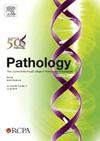Increased incidence of Hodgkin lymphoma with decreased association with Epstein–Barr virus in Taiwan: a shift toward Western style
IF 3
3区 医学
Q1 PATHOLOGY
引用次数: 0
Abstract
Previous studies have reported a global increasing trend in the incidence of Hodgkin lymphoma (HL), especially among individuals who are female, of younger age and from Asian nations. However, detailed long-term trend analyses on individual countries and investigation of reasons for these temporal trends, including Epstein–Barr virus (EBV) association, are limited. We compared nationwide registration data from Taiwan and the USA during the interval 2001 through 2020 and used an age-period-cohort model to analyse individual effects of time period and birth cohort on the incidence trends. The incidence of HL in Taiwanese people was much lower than that in White Americans (7.39 vs 28.43 per million inhabitants). However, in contrast to a slightly decreased incidence rate in White Americans, HL in Taiwanese people showed a steadily increasing incidence rate during the 20-year interval (overall annual percentage change +2.82%), especially for women with nodular sclerosis subtype and aged 25–30 years, during the period 2011–2020. The prominent increase in relative risks was revealed by the time period and birth-cohort effects in Taiwanese people compared with White Americans. Interestingly, the linear trend test demonstrated a significant decrease in EBV association in Taiwanese HL over the 20-year period, from ∼60% to ∼20% (p=0.025), with a bimodal EBV-positive pattern in childhood (<10 years, 50%) and in older adults (>70 years, 93%). These findings suggest environmental influences and Westernisation of lifestyle in HL aetiology and that improvement of public health may influence the incidence and biological features of HL.
台湾霍奇金淋巴瘤发病率增加与eb病毒相关性降低:向西式转变
先前的研究报告了霍奇金淋巴瘤(HL)的全球发病率呈上升趋势,特别是在女性、年轻人和来自亚洲国家的个体中。然而,对个别国家的详细长期趋势分析和对这些暂时趋势的原因的调查,包括eb病毒(EBV)关联,是有限的。我们比较了2001年至2020年台湾和美国的全国登记数据,并使用年龄-时期-队列模型来分析时间和出生队列对发病率趋势的个体影响。台湾人的HL发病率远低于美国白人(7.39 vs 28.43 /百万)。然而,与美国白人的发病率略有下降相比,台湾人群的HL发病率在2011-2020年期间稳步上升(总体年百分比变化+2.82%),特别是25-30岁的结节硬化亚型女性。与美国白人相比,台湾人的相对风险显著增加是由时间和出生队列效应所揭示的。有趣的是,线性趋势检验显示,台湾HL患者EBV相关性在20年间显著下降,从60%降至20% (p=0.025),儿童期EBV呈双峰型阳性模式(70岁,93%)。这些发现表明,环境影响和生活方式西方化与HL病因学有关,公共卫生的改善可能影响HL的发病率和生物学特征。
本文章由计算机程序翻译,如有差异,请以英文原文为准。
求助全文
约1分钟内获得全文
求助全文
来源期刊

Pathology
医学-病理学
CiteScore
6.50
自引率
2.20%
发文量
459
审稿时长
54 days
期刊介绍:
Published by Elsevier from 2016
Pathology is the official journal of the Royal College of Pathologists of Australasia (RCPA). It is committed to publishing peer-reviewed, original articles related to the science of pathology in its broadest sense, including anatomical pathology, chemical pathology and biochemistry, cytopathology, experimental pathology, forensic pathology and morbid anatomy, genetics, haematology, immunology and immunopathology, microbiology and molecular pathology.
 求助内容:
求助内容: 应助结果提醒方式:
应助结果提醒方式:


